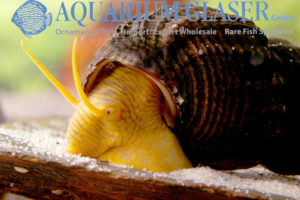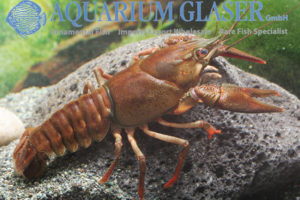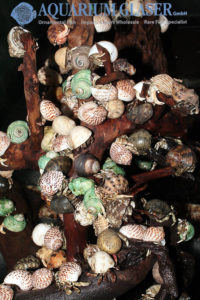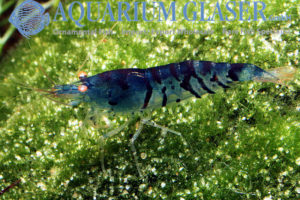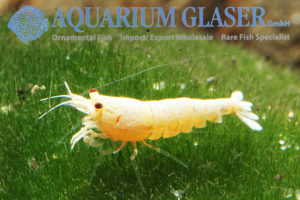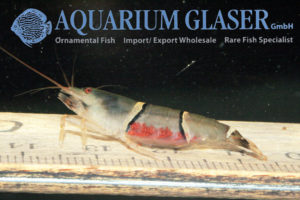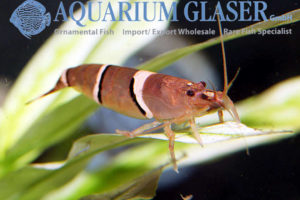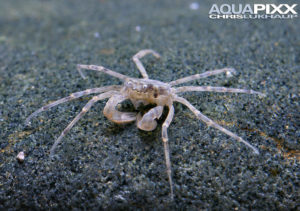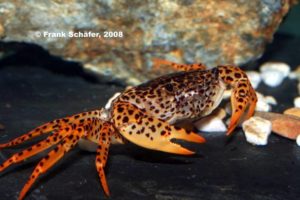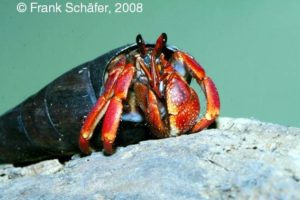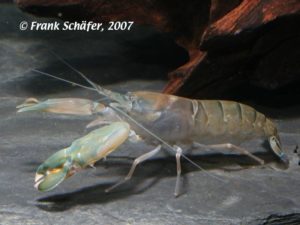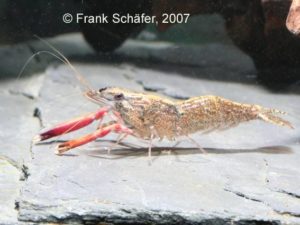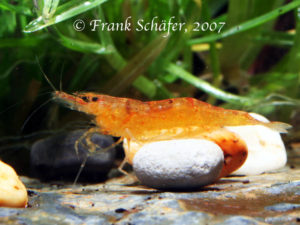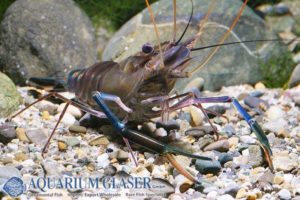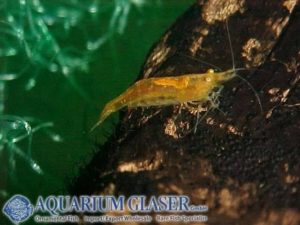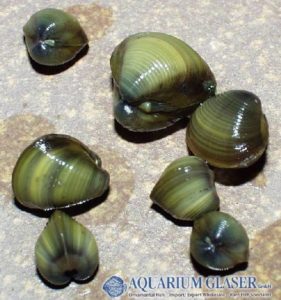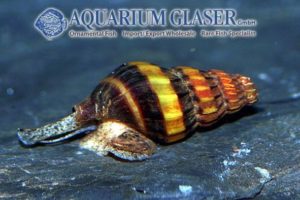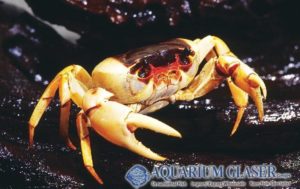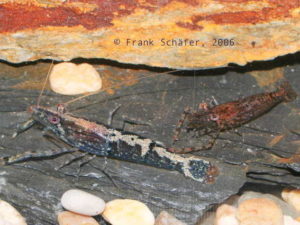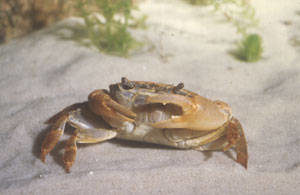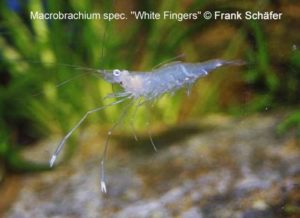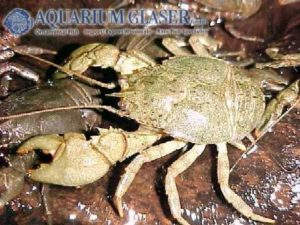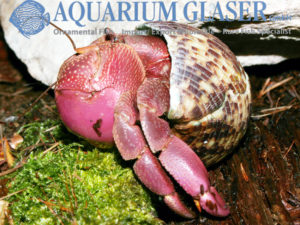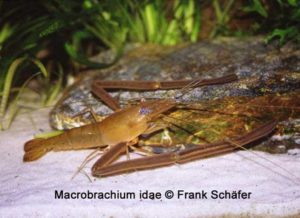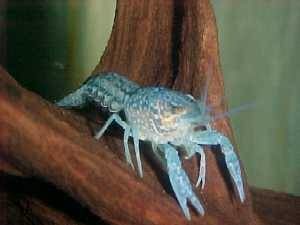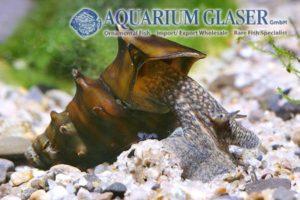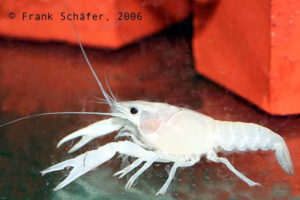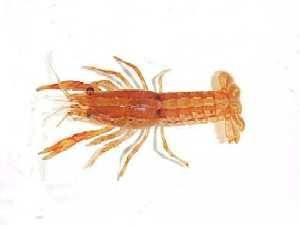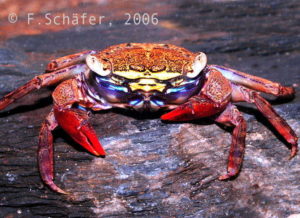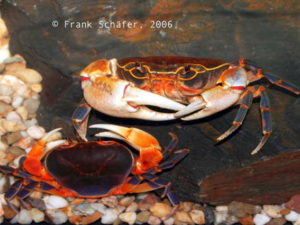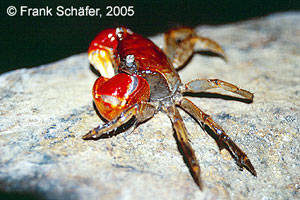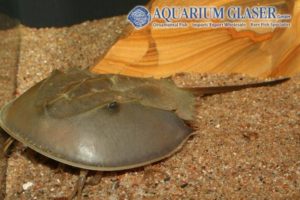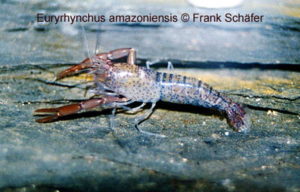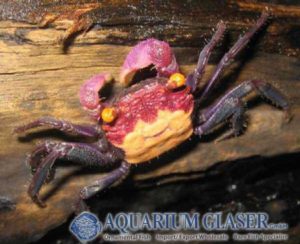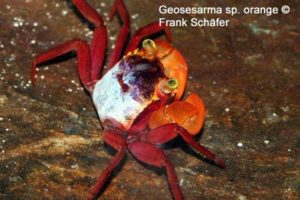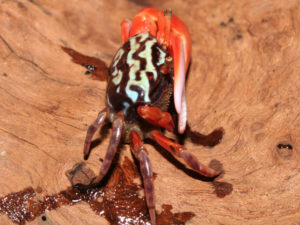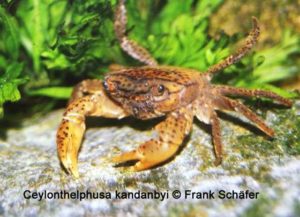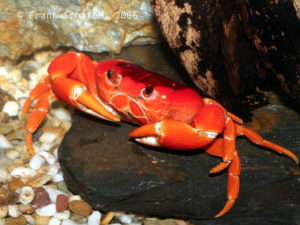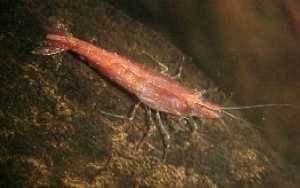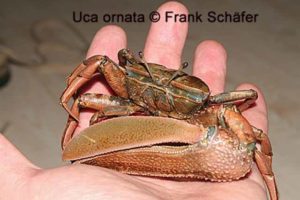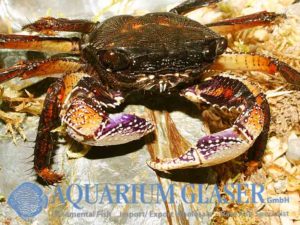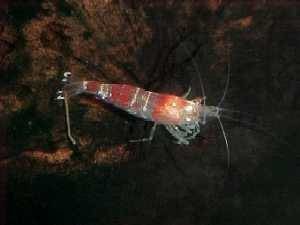Lake Poso on Sulawesi (formerly: Celebes) is not only home of beautiful dwarf shrimps, but also of large relatives of the well-known Malayan livebearing snail (Melanoides tuberculata). The brash colour of the body is really astonishing. Species of Tylomelania do not feed on algae, but on detritus. Thus some muddy corners in the tank are […]
31. Crayfishes, Shrimps, Crabs, Snails, Mussels (148)
-
-
Astacus astacus
The Noble or River cray, Astacus astacus, is sadly in danger of extinction in central Europe. The reason for this are the extreme destruction of the natural habitats in combination with the introduction of a Northamerican species between 1860 and 1870. This species, the so-called Camber cray (Orconectes limosus) was infested with a disease. This […]
-
Land hermits: Coenobita rugosus imported!
From Taiwan we were able to import beautiful land hermits. They belong to the species Coenobita rugosus, which can be recognized by the ridge-like swellings on the upper edges of the claws. The colour is very variable and can be grey, brown or reddish. Like all Coenobita species the animal likes to live in groups. […]
-
Neocaridina Deep Blue Tiger Yellow Eyes
The latest new entry in our stocklist: this is a very beautiful sport of the tiger shrimp. The blue sport is known for quite a long time. Our new stock shows extreme bright colours. Males can grow to a size of 2.5 cm, females become 3.5 cm long. For our customers: the animals have the […]
-
Neocaridina Red-Bee-Snow-White-Shrimp
Breeding of „Crystal Red“ shrimps has become a widespread hobby. These dwarf shrimps are real pets in the sense of domesticated animals, a very interesting fact under the aspect of culture history: this is the first case of a crustacean that has been cultivated for that reason since the rise of men on earth! A […]
-
Bamboo shrimps actually spawned
Last week we could introduce to you the new Bamboo shrimp, which we imported for the first time ever from Taiwan. Due to the extreme high price of the two alleged pairs we established them not in the fish house, but in our show room. Yesterday a scientist researching on these shrimps asked us about […]
-
Sensation: Bamboo shrimp from Taiwan
We are proud and happy that we were able to import yesterday the first few pairs of a new shrimp from Taiwan. According to the local scientists it belongs to a so far undescribed species. There is no doubt that it belongs to the Atya-relatives. The males of the „Bamboo shrimp“ are almost two times as […]
-
Limnopilos naiyanetri
Described in 1991, Limnopilos naiyanetri Chaung & Ng, has only just been discovered by the hobby. Crabs are found in pure freshwater in the roots of floating vegetation, ie. water hyacinth (Eichornia crassipes) and fine-leaved aquatic plants along the riparian zone (river banks). They have hairy bodies and appendages which collect mud and dirt and […]
-
Parathelphusa pantherina
(21.Mai 2008) Last week we received from the Matano Lake in Indonesia a very beautiful crab: the panthercrab. Since they live nearly totally under water, they need only a small terrestrial part in their tank. A hard water with a temperature from 25-29°C is favored. They can be easily fed with all kind of foods; […]
-
Coenobita cf.pseudorugosus
(11.Feb.2008) Again a new “crawler”: Coenobita cf.pseudorugosus. From Asia we received this super red hermit crab. The conditions to keep them are similar to all other land hermit crabs. Noteworthy are the nice flats they carry: from screwdriver snails of 5-6cm which the hermit quit the leasing contract…because of own requirement….(Photo F.Schäfer, Text R.Neunkirchen)
-
Alpheus cyanoteles
(17.Dec.2007) Pistolshrimp…that`s what they are called. Currently we have a very limited number in stock. Generally this is a brackish item, which is totally adapted to live in freshwater. They come from the peninsula of Malaysia. They can create a sound like the shoot of a pistol, which is why they are called Pistolshrimp. You […]
-
Macrobrachium sp.RED CLAW
This amazing shrimp arrived last week: Macrobrachium sp.RED CLAW. We received a very limited number of this item, which is coming from east Borneo. Our supplier told us that he never shipped them to Europe before. This picture is showing a male, if you click on the small blue fish next to the picture, you […]
-
Caridina cf. propinqua
30.Nov.2007) Now we are happy to have them available in big numbers : the mandarinshrimp, Caridina cf. propinqua. Yesterday we received a good quantity of this beautiful shrimp from our supplier . Their origin is the isle of Sulawesi. So far we can say are they easy to keep; the females grow up to 2cm […]
-
Macrobrachium rosenbergii
(26.Nov.2007)The genus Macrobrachium rosenbergii is playing a very important role in the Aquaculture in many regions of asia. Mainly in Thailand they are bred in huge numbers for human consumption. This shrimp belongs to the family Palaemonidae and from time to time they are mported to Europe. But when you find this very nice shrimp […]
-
Caridina cf. propinqua /Orange Shrimp
A NEW ARRIVAL of the week: Cardina cf. propinqua! This beautiful orange shrimp arrived yesterday. The latin name is Caridina cf. propinqua. We got a limited number of this extreme nice shrimp. Basically they are easy to keep, but if they will start to loose their colour, you just have to reduce the pH. This […]
-
Corbicula sp.
From Corbicula sp., a maximally 3 cm long mussel, we can offer 2 different colour types. They are hermaphrodites, whose larvae do not, contrary to some other kinds of mussels, exhibit parasitical stages. Since they filter their food from the water, they clean it of suspended matters, bacteria and protozoa. So they can be called […]
-
Anentome helena
mg class=”alignnone size-full wp-image-147928″ src=”http://www.aquariumglaser.de/wp-content/uploads/Anentome-helena.jpg” alt=”” width=”591″ height=”394″ /> From now available: the snail-eating snail ANENTOME HELENA. This item coming from asia, is perfect cleaning your tank from snails. The snail is finding her victims with her trunk. With a total length of about 1,5cm is this item also suitable for very small tanks, in […]
-
Demanietta sirikit
Just last week we got a few pieces of the beautiful thai crab Demanietta sirikit! This crab lives in 50-100cm long tunnels near by the riverside. They are building their homes so deep until they reach the level of the groundwater. In the mating season they look for a partner. This happens during the rainy […]
-
New Crab
June 2006: Is considered already nearly as rule: Every week we get an new crab. Under the trade name “goldenpincer crab” we could firstly import few exemplars of a new, still undescribed crab species from Southeast Asia. Further iInformation will follow. (Photo C.Luckhaup, Text K.Diehl)
-
Macrobrachium brasiliensis
July 2006: From the Amazon area we could import an rarely imported Macrobrachium species. Macrobrachium brasiliensis has a large area of origin from French Guyana to Peru in the basins of the Amazon and Orinoco. There they inhabit predominantly small creeks full of leaf litter. They feed mainly on detritus and are an important member […]
-
Oziothelphusa ceylonensis
An amazing variety of crustaceans can be found in tropical fresh- and brackish water areas. Only few species however are imported regularly. Recently this species was imported which comes from Sri Lanka, as one could guess from its name. O.ceylonensis is a pure freshwater species, with a carapax width of 6 cm and a colour […]
-
Palaemon concinnus
Over an enormous range, that includes nearly the entire Indo Pacific those first as Macrobrachium “White Fingers” designated Palaemon concinnus can be found. Their bright white “shear-fingers” are very remarkable and give this from Sri Lanka imported species a special attraction. It is about a rather delicate, smaller species, thus one could try to socialise […]
-
Aegla platensis
There are more than 60 species, all of them exclusively inhabitants of freshwater, in the genus Aegla, which belongs to the family Aeglidae. All Aegla species are inhabitants of southern South America. To date they have hardly ever been seen in the aquarium hobby. The specimens recently imported by Aquarium Glaser demonstrate, however, that Aegla […]
-
Coenobita brevimanus
The hermit crab C. brevimanus origins from coasts of the Indopacific, where it is found from the east coast of Africa to Tahiti. Coenobita brevimanus is the most terrestrial of all land hermit crabs. For the maintenance one needs a terrarium with only shallow water, because they do not like to get wet. Since they […]
-
Macrobrachium idae
January 2006: The long arm shrimp Macrobrachium idae reached us from Sri Lanka. Remarkable are their extreme long, name-giving “arms”, which can give the full grown animals an enormous broad reach. With that they are able to track small fish successfully, which naturally limits their use in the community tank. Together with larger fish species […]
-
Procambaris sp. marbled blue
March 2002: This nice blue colour variant of the Marmorkrebs (the initially German name is now in international use and means „marbled crayfish“) is actually available. The Marmorkrebs is a remarkable species, because until now only females are known. The species breeds parthenogentically, eg females lay unfertilized eggs and produce only females again. As the […]
-
Brotia pagodula
(28.Nov.2007) From Southeast Asia we got a still rarely traded snail species. Brotia pagodula is a live-bearing snail, as an endemic species it can be found only in the Moei, a river between Myanmar and Thailand. Their strongly wound house, provided with numerous spikes, gives them a bizzare appearance. On the search for algae they […]
-
Procambarus clarkii „WHITE“
Under the numerous color forms of the Red Swamp Crayfish is Procambaris clarkii „White ” at present very popular. They are tough tank inhabitants, easily to reproduct and possess a high reproduction rate. Procambarus clarkii does not place large requirements towards the water chemistry, a strong filtering is however necessary, since they have a strong […]
-
Cambarellus patzcuarensis
November 2003: New arrival! The orange dwarf lobster, Cambarellus patzcuarensis. They grow only up to 3-4cm. Just yesterday we got a very limited quantity from a german breeder. These dwarf lobsters are slightly agressive among each other. The origin is the lake Patzcuaro in Mexico.(Photo F. Schäfer, Text K. Diehl)
-
Sesarma spec. „Neon Face“
April 2005: These days we got a new crab species from Asia. The blue green irisdescent coloration of its face advised the name „Neon Face“. If further information is available, we will add it to our text.(Photo F. Schäfer, Text K. Diehl)
-
Camptandrium sp.
July 2006: Few days ago we could import a new attractive crab species. It belongs to the genus Camptandrium, the species is yet not determined. They originate from India, where they were caught on the banks of the Ganges river in the proximity Calcuttas. There they live in estuaries and a therefore a salt additive […]
-
Demanietta spec. Laos
From the border area of Laos and Thailand origins the expressed beautiful fresh water crab Demanietta spec. „Laos“. They exist in different colour forms. Fresh water crabs need an aquarium with a land- and water part. Some branches or stones will offer them climbing possibilities. As omnivores they despise nearly none of the usual crab-food, […]
-
Sesarmops intermedium, Flower Crab
This crab is known under the trading name “Flower Crab”. It will not outgrow 4 cm, measured by its carapace. These crustaceans have two large, red claws, which could weigh up to half the total body weight. In nature they feed mainly on algae and other organic material, which they catch with smaller pincers. The […]
-
Carcinoscorpius rotundicauda
Horseshoe crabs are rightfully described as living fossils, because their ancesters populated the warm flat seas about 500 million years ago.The description of the horseshoe crab is misleading because their next relatives are arachnids and not the crabs. The Moluccan-horseshoe crab that is being presented, comes from southeast Asia and lives in coastal ranges from […]
-
Euryrhynchus amazoniensis
April 2006: Now available again: Euryrhynchus amazoniensis a rare shrimp species from South America. The delightful pattern of points and stripes on their body justifies its English name Peru Zebra Shrimp. For a long-lasting maintenance the only 3 cm large getting species needs low pH values and soft water, since otherwise a certain susceptibility against […]
-
Geosesarma sp. VAMPIRE
March 2006: They are among us. Fortunately only in a small number: Vampire crabs! With a close look the horror will pack you, remind the ends of its shears very strongly of the carnassial teeth of vampires. At night one would like to meet them with their shiny red eyes in no case. Now in […]
-
Geosesarma sp. „orange“
March 2006: The mandarin crab, a further still undefined Geosesarma species, reached us these days from Sulawesi. It is characterised by a very intensive red-orange colouring of the legs and particularly the claws as well as bright yellow eyes. Thus it represents a beautiful coloured contrast to the last week introduced vampire crab. Whether a […]
-
Uca annulipes
May 2005: One of the most beautiful fiddler crab, Uca annulipes has been available now. Fiddler crabs, a family of 65 species, live worldwide in tropical and subtropical areas where they inhabit beaches and swamps. They reach a length of no more then 2.5 to 3 cm. The male animals have one large and often […]
-
Ceylonthelphusa kandanbyi
The leopard crab Ceylonthelphusa kandanbyi represents an attractive addition to the offered crustaceans. This 1999 scientifically described species originates from Sri Lanka where it is found in the Bentota river system. According to statement of our supplier the animals were caught in the proximity of Mathugama city a town in the western part of Sri […]
-
Gercarcinus ruricola
This splendid land crab (Halloween-Crab, Gercarcinus ruricola) occurs in two colour variants, specifically with red or white base coloration. The colour variation involves both sexes. A mixed pair lived together in harmony for several weeks in my terrarium. These creatures are essentially vegetarian, but will occasionally take frozen foods intended for aquarium fishes, eg bloodworm. […]
-
Neocaridina sp FIRE/CHERRY
July 2004: Yesterday we got a limited number of this beautiful shrimp, which belongs to the family of Neocaridina. This type was imported one year ago, but also only in small numbers. They do not demand special water parameters and can be easily fed with common fish food. They can be kept in community tanks, […]
-
Uca ornata
January 2006: For the first time in Germany: The fiddler crab Uca ornata. We are proud to introduce this new species to the pet market. We got only few animals from Ecuador, hope however for further imports of this species. Further information for the maintenance of this at the Pacific coast from Ecuador to Nicaragua […]
-
Goniopsis pelii
June 2006: The mangrove crab Goniopsis pelii reached us from the Atlantic coast of Africa. Their orange and blue coloured claws are very remarkable. They owe their name to the mangrove woods where they naturally occur. This by water and land affected biotope has to be reproduced in the terrarium, since they need both habitats […]
-
Neocaridina sp RED CRYSTAL SHRIMP
December 2002: Here we have it: german bred red crystal shrimp. We only got a few pieces, but we expect a limited quantity in the near future. This shrimp of the family Neocaridina is easy to keep and can be kept with not too big growing fish in a community tank (Photo F. Schäfer, Text […]
-
Uca tangeri
The eastern Atlantic from Portugal to Angola, is the origin of the fiddler crab Uca tangeri, where they inhabit sand and mangrove coasts. The to an enormous size grown major claw of the males is remarkable. It is used for attracting the females and to the fight between rivaling males. In their periodically flooded habitat […]
-
Cherax lorentzi
In its shining armour Cherax lorenzi reminds of a medieval knight, who is on its way to the tournament. With a size of 12 cm it can be kept very good in aquariums starting from 100 cm length. Contrary to some of its relatives Cherax lorenzi does not seem to harm other tank mates. Therefore […]
Colorful Great Ramshorn snails
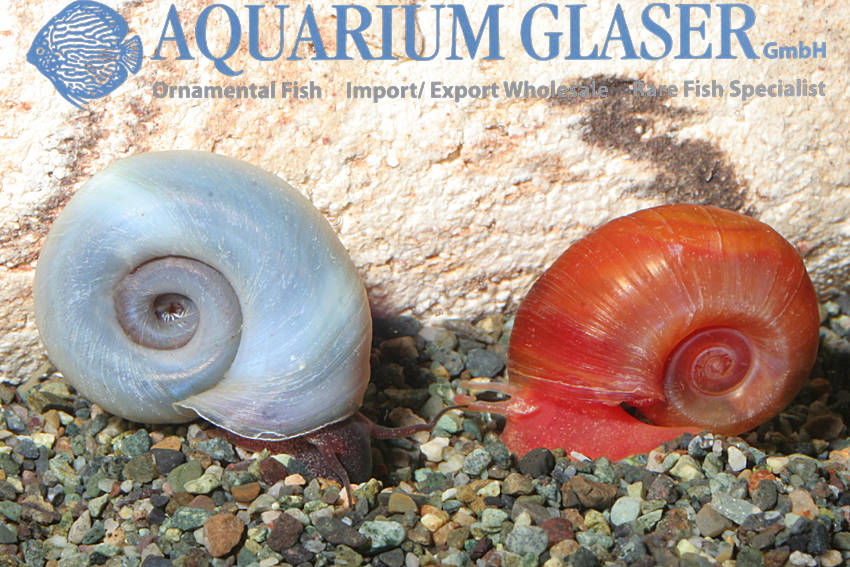
The Great Ramshorn snail (Planorbarius corneus, formerly known as Planorbis corneus) is kept in aquaria and garden ponds since the beginning of the hobby. They grow to a relatively large size (maximum 4 cm) and do not touch living plants. They feed exclusively on algae and detritus. This snail has a red blood that contains hemoglobin. Thus albinos have a bright red body.

The wild type of the Great Ramshorn is imported each year from eastern Europe for pond keepers. Now and then these shipments contain also albinos.
Now breeders in Singapore were successful in breeding full red and blue sports of this snail. For the first time we are now able to offer these attractive animals.

Keeping and breeding of the Great Ramshorn is extremely easy. As they are hermaphrodites, two animals are in any case a pair. They breath through lungs and so at least a part of the oxygen they need is taken from the air. The maximum age they can reach is about 3 years, but in the wild only very few specimens get that old. The water temperature should be between 12 and 25°, hardness should be at least 10°KH (more is better), the pH can be between 6.5 and 8.5.
For our customers: the wild Great Ramshorn has code 879403, the bright red 486522, the blue one 486512 on our stocklist. Please note that we exclusively supply the wholesale market.
Text & photos: Frank Schäfer
NEW NEW NEW: neon blue clams!

New arrival of the week: a neon blue coloured mussel from Asia.
Sorry that we only have a very limited number of this extreme
nice and rare species available. They belong to the family
POLYMESODA… sorry, but so far we do not have more information
about this big (5-7cm) unknown beauty.





